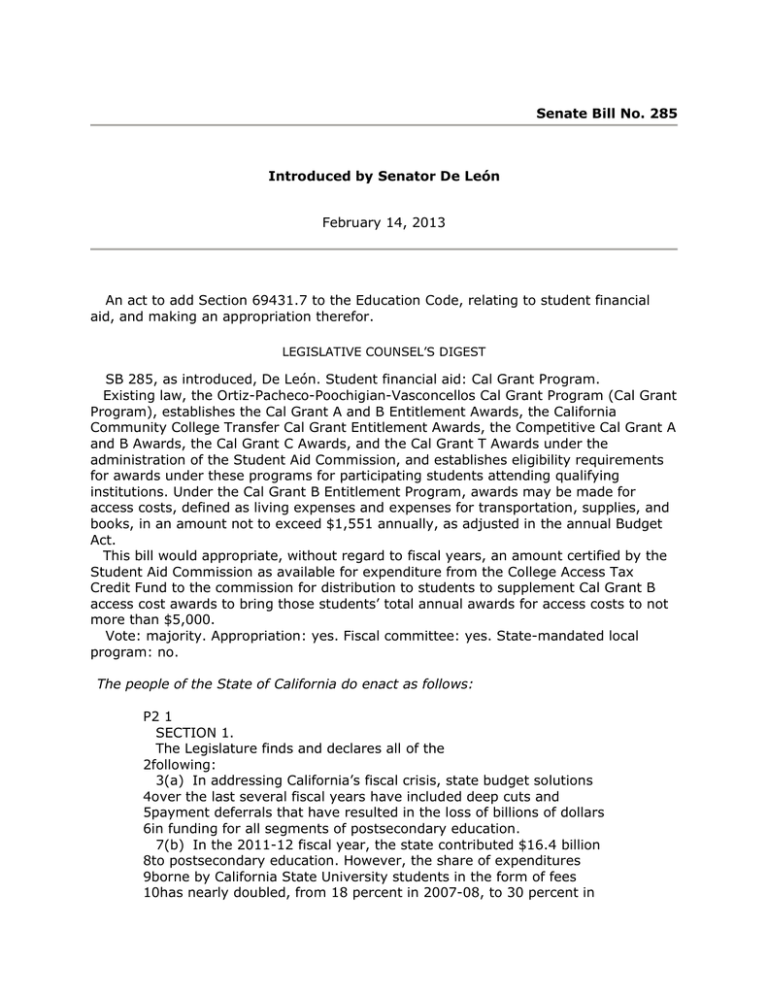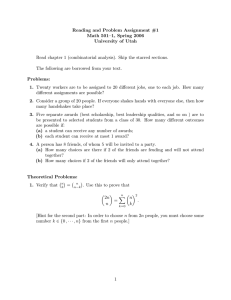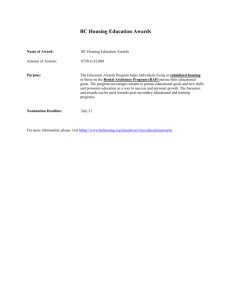Senate Bill No. 285 Introduced by Senator De León February 14, 2013 An act to add Section 69431.7 to the Education Code, relating to student financial
advertisement

Senate Bill No. 285 Introduced by Senator De León February 14, 2013 An act to add Section 69431.7 to the Education Code, relating to student financial aid, and making an appropriation therefor. LEGISLATIVE COUNSEL’S DIGEST SB 285, as introduced, De León. Student financial aid: Cal Grant Program. Existing law, the Ortiz­Pacheco­Poochigian­Vasconcellos Cal Grant Program (Cal Grant Program), establishes the Cal Grant A and B Entitlement Awards, the California Community College Transfer Cal Grant Entitlement Awards, the Competitive Cal Grant A and B Awards, the Cal Grant C Awards, and the Cal Grant T Awards under the administration of the Student Aid Commission, and establishes eligibility requirements for awards under these programs for participating students attending qualifying institutions. Under the Cal Grant B Entitlement Program, awards may be made for access costs, defined as living expenses and expenses for transportation, supplies, and books, in an amount not to exceed $1,551 annually, as adjusted in the annual Budget Act. This bill would appropriate, without regard to fiscal years, an amount certified by the Student Aid Commission as available for expenditure from the College Access Tax Credit Fund to the commission for distribution to students to supplement Cal Grant B access cost awards to bring those students’ total annual awards for access costs to not more than $5,000. Vote: majority. Appropriation: yes. Fiscal committee: yes. State­mandated local program: no. The people of the State of California do enact as follows: P2 1 SECTION 1. The Legislature finds and declares all of the 2following: 3(a) In addressing California’s fiscal crisis, state budget solutions 4over the last several fiscal years have included deep cuts and 5payment deferrals that have resulted in the loss of billions of dollars 6in funding for all segments of postsecondary education. 7(b) In the 2011­12 fiscal year, the state contributed $16.4 billion 8to postsecondary education. However, the share of expenditures 9borne by California State University students in the form of fees 10has nearly doubled, from 18 percent in 2007­08, to 30 percent in 112011­12. A public postsecondary education has become 12unaffordable for the middle class. Most students are leaving school 13thousands of dollars in debt, and they end up sending monthly 14payments to out­of­state banks rather than contributing to the local 15economy. 16(c) With less access to postsecondary education due to courses 17being cut, each year students are taking longer and longer to 18graduate. It now takes the average student seven years to graduate 19from a California Community College campus, six and one­half 20years to graduate from a California State University campus, and 21four and one­half years to graduate from a University of California 22campus. 23(d) Educational attainment levels predict the overall economic 24performance of states and nations. California was always among 25the top states in degree­completion rates, but it now ranks among 26the bottom 10 states. 27(e) By 2018, 63 percent of all jobs in the United States will 28 require some form of postsecondary education or training, 29according to estimates by the Georgetown University Center on 30Education and the Workforce. The United States is on track to 31deliver only a fraction of this education. Currently, only 38 percent 32of America’s young adults have a college degree, compared to 58 33percent in South Korea. 34(f) California’s postsecondary education system has helped 35build and sustain an entrepreneurial spirit that has shaped new 36sectors of the state’s economy. During tough times like these, we 37need novel approaches to steer the state back on track. P3 1(g) Estimates show that the College Access Tax Credit Fund 2will be fully subscribed for each of the three years of the program, 3allowing the California Student Aid Commission to fund larger 4access grants to California’s neediest students. 5(h) All Californians deserve access to an affordable 6postsecondary education. 7 SEC. 2. Section 69431.7 is added to the Education Code, to 8read: 9 69431.7. (a) As used in this section, “fund” means the College 10Access Tax Credit Fund created by Section 17053.86 of the 11Revenue and Taxation Code. 12(b) Any moneys that may be appropriated from the fund for 13purposes of this section shall be in addition to, and are intended 14to supplement, other moneys appropriated for the Cal Grant 15Program. Upon the creation of the fund, and during its existence, 16the amount of the Cal Grant B access award as established in the 17annual Budget Act shall not be adjusted below the amount set forth 18in the Budget Act of 2012. 19(c) On April 1, 2015, and on April 1 annually thereafter, the 20commission shall certify the amount of moneys available for 21distribution from the fund for the academic year commencing the 22following July 1. The amount available for distribution in any 23academic year shall not exceed 85 percent of the certified fund 24balance. Notwithstanding any other law, the commission shall 25thereafter determine the amount of the supplemental awards to be 26granted. The amount certified by the commission under this 27subdivision is hereby appropriated to the commission, without 28regard to fiscal years, for the purpose of making awards to students 29in accordance with this section. 30(d) If, after making supplemental awards pursuant to subdivision 31(e), moneys remain in the fund, those moneys shall remain in the 32fund for allocation in future fiscal years. 33(e) Disbursements shall be made under this section to 34supplement awards made for access costs under Article 3 35(commencing with Section 69435), Article 4 (commencing with 36Section 69436), and Article 5 (commencing with Section 69437). 37The amount of the supplemental award, when added to the amount 38of the award made for access costs established by the annual 39Budget Act, shall not exceed five thousand dollars ($5,000). An 40award under this section is payable only to the extent that moneys P4 1are available from the fund. The commission shall inform each 2recipient of an award under this section that the award is for one 3academic year only, is not an entitlement, and that future 4supplemental awards are subject to the availability of moneys in 5the fund. O 99



